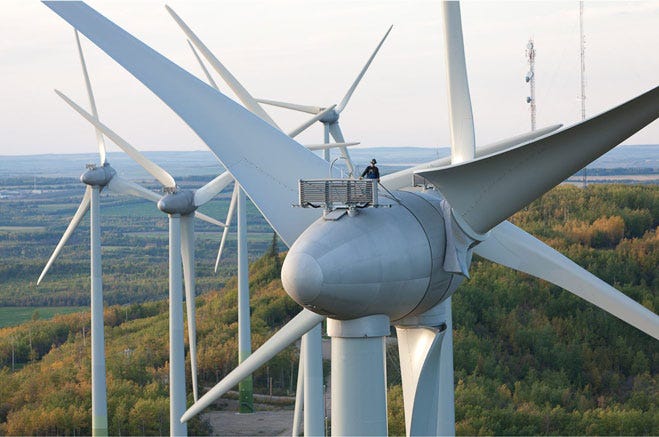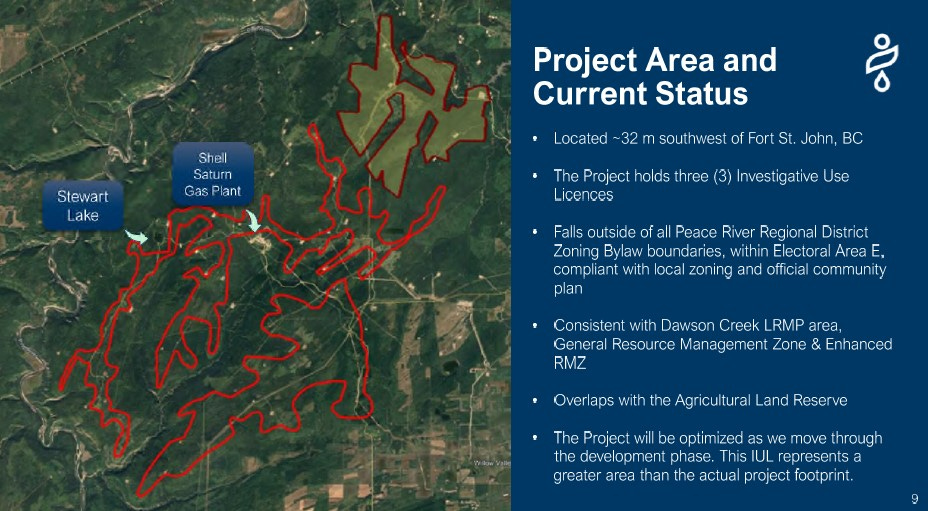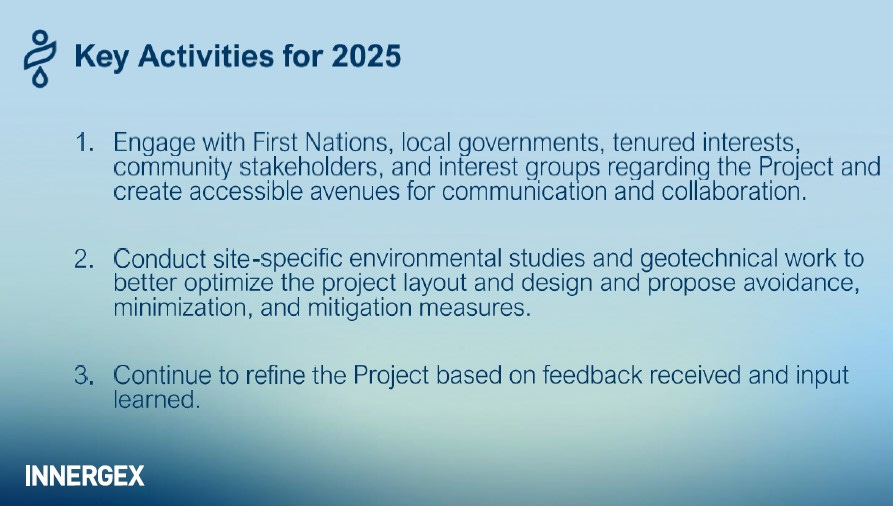Be transparent in communications, PRRD board tells wind farm proponent
Transparency in communications, conducting engagement with all people in the Peace River Regional District, not just First Nations, and a willingness to be flexible is key to a successful, well-thought out project.
Innergex Renewable Energy gave a presentation to the PRRD board of directors on May 1, about its Stewart Creek Wind Project, which is planned for Area E of the regional district, around Stewart Lake, Septimus and Shell Canada’s Saturn Gas Plant in Groundbirch. While most of the project will be constructed on Crown Land, grazing tenures in the area will be impacted by the 35, 6 megawatt turbines which make up the project.
By the time the wind farm is up and running, the project will have been over 20 years in the making, according to Cara Vickers, Senior Project Developer for Innergex, who said they began working on the project in 2008, and hopes to be in operation by late 2030.
Since 2022, Innergex has been measuring the wind resource in the area under an investigative use licence (IUL) with meteorological towers and Lidar stations, before being awarded the electricity purchase agreement (EPA) from BC Hydro in December 2024.
Now that Innergex has an EPA, Vickers says they will be begin further development of the project with some initial studies, permitting under the BC Energy Regulator (BCER) and further design.
“We’re going to do that through further engagement and collaboration with different interest holders and stakeholders, community groups, the First Nations of course, from now until 2028. Then in 2029, we’ll go into construction, which is a two-year construction phase typically, and then in late 2030 we’re going to go into operation. We have a thirty-year term for operation, and then after that, decommissioning,” Vickers said.
She also says they understand that the project area overlaps the Agricultural Land Reserve (ALR) so they will work with “interest holders and those individuals who are impacted on the agricultural land reserve to make sure that this project isn’t harming with that.
“One nice thing about wind projects is that agricultural activities can still commence on the land even if there might be a turbine in that area.”
Vickers added that in the prairies, farmers can still harvest all their crops and “do all those normal agricultural activities”, with wind turbines on the land.
This year, besides the planned engagement with “interest holders”, and continued measuring of the wind resource, Innergex will start environmental studies and geotechnical work to optimize the project layout, as well as acoustic studies to ensure the project stays around 40 decibels, which Vickers describes as “a little bit louder than a whisper that you’d hear in a library.”
“All in an effort to really promote our project and create avenues for communication with us on the project, so we can hear concerns, address it, as well as make sure that we can teach the community more about wind power, and what that means for the community and the kinds of benefits that will come from that.”
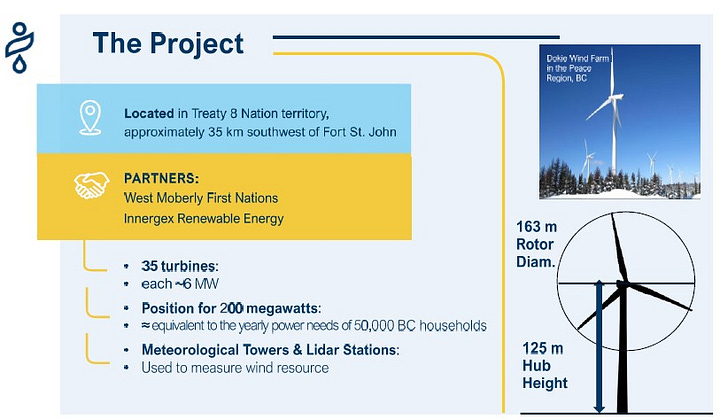
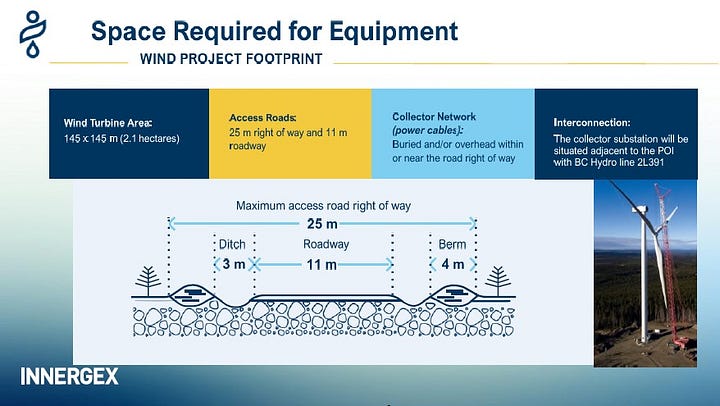
Vickers noted that they have already heard some concerns in the region, particularly around the impacts to moose, caribou and wetlands. While Innergex doesn’t develop in wetlands, they are looking to see how they can work with First Nations to support their wetland initiatives, which will in turn help moose and beaver populations.
“We are trying to work with the nations on seeing how we can minimize our impacts on the project but also help restore maybe other regions that have been impacted by development in the past.”
Cumulative impacts affect more than First Nations
Grazing tenures in the project’s vicinity concerned Area E director Dan Rose, who said he hoped those are the people Innergex has already talked to.
Rose also noted that the project is in Management Unit 7-32, where a lot of hunting opportunities have already been lost due to cumulative impacts of oil and gas, and logging, and asked how Innergex planned to mitigate further damage to habitat. He also noted the only camping opportunity in the area is at Stewart Lake.
“This pretty well destroys that, I would think.”
The lack of maps of where the power lines are going also concerned Rose.
“It pushes the cumulative impacts beyond saturation for that particular area. It’s a very busy area and there’s still a lot of active tenure that hasn’t been developed there.”
Vickers said they plan to work with oil and gas companies and try to use existing roads as much as possible, adding that although they have sent letters out to tenure holders, but have so far been unable to “connect with them directly to hear their concerns and better understand how they use the land.”
“We are working with the nation. We’re actually talking with them right now about how we can help with wetland initiatives in the region to restore more wetlands so that it not only helps return key species like moose into the area,” she said.
“In terms of the Stewart Lake site, our turbine layout so far is we’re moving more towards the east-northeast of it, so less around Stewart Lake, and that’s partly because of what we’ve been hearing from different engagement sessions we’ve had.
“We’re going to try to position the project further away from that so people can still enjoy what Stewart Lake has to offer.”
Craig Noordmans, Innergex’s Indigenous relations officer added that they’re starting up conversations with First Nations, discussing ongoing initiatives and how they can add to them with input from organizations such as Ducks Unlimited and the BC Wildlife Federation who also have initiatives planned with First Nations.
In terms of range holders, Noordmans said they have reached out to ATV clubs and recreationalists in the area, and that the main impact of the Stewart Creek Wind Farm is primarily visual at Stewart Lake.
Rose said he’s glad they’re discussing things with people, but “you need to expand it so that everybody knows what’s going on. And if you show up there to teach people about wind, I don’t think it’s going to go over very well. We’ve had wind in this area for quite awhile now.”
“I think you’re missing the boat on a few things already. It’s more than just First Nations that you need to be talking about as far as hunting opportunities and camping opportunities,” he said. “Treaty 8 is an agreement to share the land, and we’re all Treaty people. And we expect to be inclusive to everybody. We’re getting letters from other First Nations that are fairly unhappy about the lack of discussion with them.”
Be open and transparent with the public
Rose suggested that when talking to the public, Innergex needs to show up with mitigation opportunities and a willingness to change and add some flexibility to their proposals.
Noordmans asked the board for suggestions on how to approach local residents, how to engage with them beyond “sending out a hundred letters.”
Dawson Creek director and mayor Darcy Dober said that as elected officials, communication is key in all aspects of what they do, and that in-person is much more effective than using social media.
“I find the more I can get in front of people, the more success I have,” Dober said. “People appreciate it more when you take the time and get in front of them and have those conversations, whether they’re hard or easy, just be open and transparent.”
On the subject of being open and transparent, Rose said that there has been some angst and noise in the community about Innergex approaching private landowners about leasing land for another project.
“Are you guys involved in trying to tie up, or create lease agreements with private landowners for another project that hasn’t been approved yet?”
Vickers said they are “definitely looking at sites to potentially have wind projects in the region.” One of these projects will be on private land, so they are already reaching out to landowners in the region.
“I think you need to be clear what you’re talking to people about, that it is not an approved project yet, because there are folks, because of this last call for power, and we know there’s another one coming, but they don’t,” Rose said.

